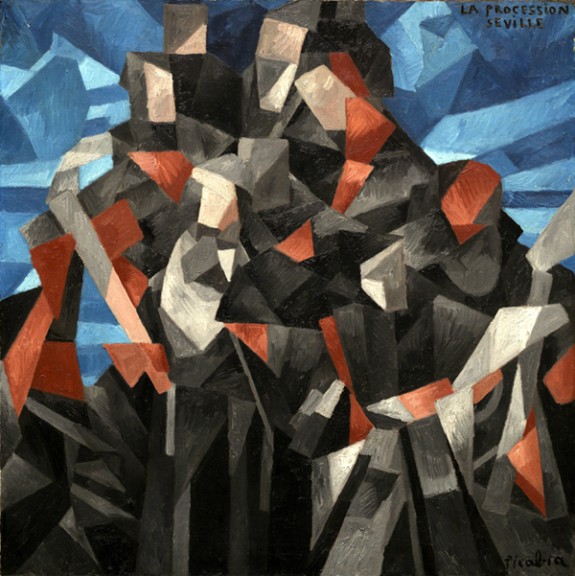Artist Birthday: Francis Picabia
Francis Picabia was a standout Cubist painter who avoided the common subject matter of Cubism, still life and portraits, opting for documenting personal experiences and memories.
Artist birthday for 22 January: Francis Picabia (1879–1953, France)
Francis Picabia was a standout Cubist painter who avoided the common subject matter of Cubism, still life and portraits, opting for documenting personal experiences and memories.
 |
| Francis Picabia, The Procession, Seville, 1912. Oil on canvas, 48" x 48" (121.9 x 121.9 cm). Courtesy of the National Gallery of Art, Washington. © 2025 Artists Rights Society (ARS), New York. (NGA-P1005piars) |
As early as the 1890s, Paul Cézanne (1839–1906), a French Post-Impressionist, was searching for a new vision of pictorial space in painting based on simplified, basic geometric forms of the cube, cone and sphere or cylinder, rather than on directly observed nature, the realm of Impressionism. In his late work he defined form by faceted, simplified shapes in which cool and warm colors defined shadow and highlight. He had introduced multiple vantage points in a single composition, although all at one particular moment.
Pablo Picasso (1881–1973) and Georges Braque (1882–1963) took Cézanne's idea and took it a step farther, including the element of time to multiple vantage points of a subject. They developed the style Cubism after a brief and intense period between 1908 and 1914. The two artists collaborated after they realized that they were both searching for new ways to define pictorial space. Their efforts created an excitement in the art world in Paris when the implications of the style's possibilities of revolutionizing the very nature of creating new forms were understood.
Already by 1911, Cubism was being explored by many artists in Paris beyond Picasso and Braque. By 1912, the Salon of Independents featured so many works in variations of the style that the artists were called "Salon Cubists." What these artists realized was the flexibility of Cubism and how it could be exploited in numerous different ways. The book On Cubism, published in 1912 by Jean Metzinger (1883–1956) and Albert Gleizes (1881–1953) was the first theoretical study of the movement. By that year, Cubism had been exhibited all over Europe, Russia, and the United States.
Picabia was born in Paris to a wealthy Spanish French family. As a child he grew up in a household devoted to the collection of art and photography. In 1895 he studied at the School of Decorative Arts in Paris, and later in the studio of painter Fernand Cormon (1845–1924), an academic symbolist/realist. Fellow pupils included future Cubists Braque and Marie Laurencin (1883–1956). At the time he produced watercolors, but quickly transitioned to oil in an Impressionist style influenced by Camille Pissarro (1830–1903) and Alfred Sisley (1839–1899).
Although his first show of his Impressionist landscapes in 1905 received positive attention, he abandoned what, by that time was considered a conventional style and gravitated towards more modernist experiment, initially Fauvism. By 1912 he had shifted to Cubism, abandoning the representation of nature to one expressing memories and personal experiences.
Unlike many of the other artists experimenting with Cubism, Picabia considered the style a good vehicle for conveying personal feelings, rather than sticking to still life and portraiture as the others did. Because of the ephemeral nature of memories and experiences, Picabia's Cubism quickly became non-objective, whereas the other Cubists rarely ventured completely away from recognizable objects.

Comments